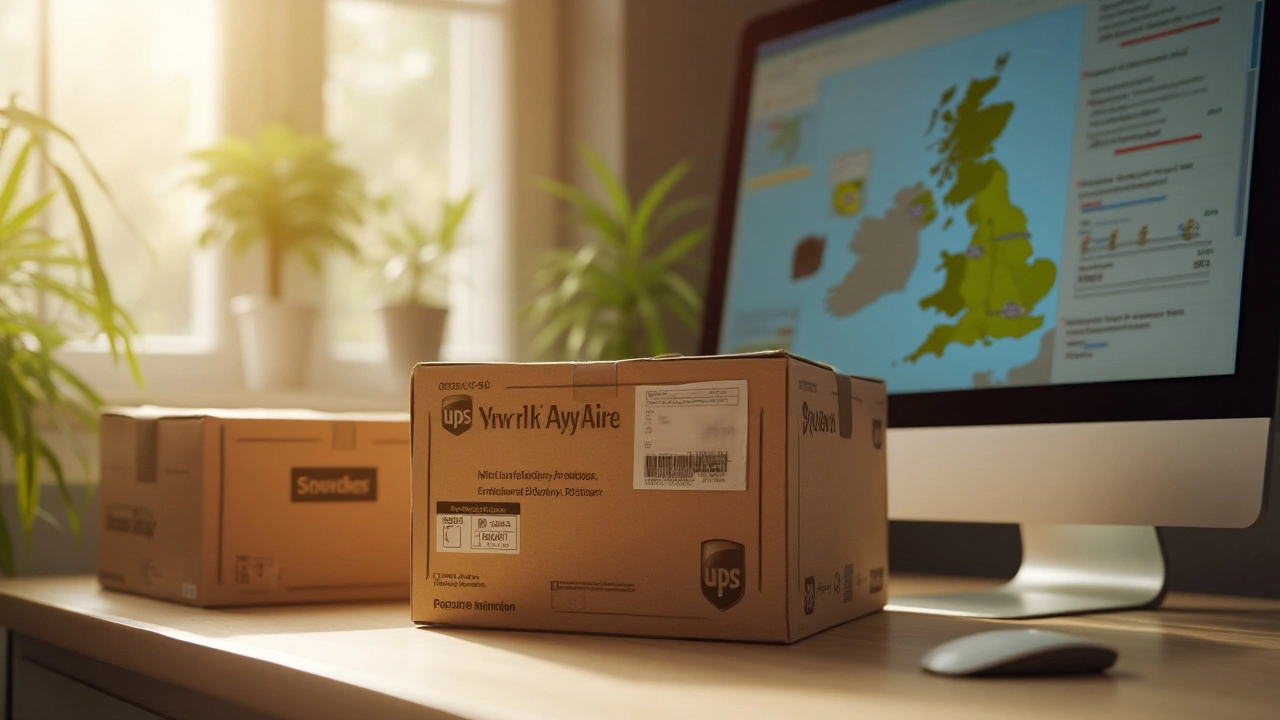Understanding UPS Next Day Air and Overnight Deliveries

In the fast-paced world of shipping and logistics, ensuring that your package arrives on time can often seem like a high-stakes game. Two popular options for those looking to send something quickly are UPS Next Day Air and overnight delivery services. Yet, the terms often leave people scratching their heads—is there really a difference between these two?
This article aims to unravel the mystery surrounding these delivery options by examining their features, speed, reliability, and cost. Whether you're a business in need of urgent shipping solutions or an individual looking to send a last-minute gift, understanding these services can empower you to make informed decisions. Let’s dive into the specifics and help you navigate this express world of parcel delivery.
- Defining UPS Next Day Air
- Understanding Overnight Delivery
- Comparing Speed and Reliability
- Cost Considerations
- Ideal Use Cases
- Tips for Maximizing Delivery Efficiency
Defining UPS Next Day Air
When it comes to swift and reliable shipping, UPS Next Day Air stands as a popular choice among both individuals and businesses who need their packages transported promptly. But what exactly does this service entail? As one might anticipate from its name, UPS Next Day Air promises to deliver packages by the next business day, ensuring speediness and reliability for urgent shipments. This service is designed to meet the expectations of those who have time-sensitive deliveries, be it important documents or a special package that simply cannot wait.
Speed isn't the only beneficial aspect of UPS Next Day Air. Reliability and convenience play crucial roles as well. Customers can drop off their UPS Next Day Air packages at various UPS locations, or schedule a pickup at their office or home, making the process flexible and user-friendly. Moreover, UPS offers a money-back guarantee with this service. If a package doesn't arrive as promised, customers may be eligible to request a refund of the shipping cost. This guarantee illustrates just how confident UPS is in its ability to deliver on time.
For those wondering what kind of timings to expect, UPS usually delivers these packages by 10:30 AM the following business day for most destinations in the continental United States. This is not just about moving goods; it’s about keeping promises. Businesses especially view this service as critical, often using it to maintain client satisfaction and uphold their reputation. A staff member from ACME Corp once said in a logistics forum,
"Relying on UPS Next Day Air has placed us ahead of the competition; our clients appreciate the reliability and speed with which we respond to their needs."Ultimately, the service covers not only the U.S. but over 100 international destinations, making it a global choice for urgent deliveries.
There are weight and size restrictions to bear in mind as well. A package should not exceed 150 pounds nor surpass 108 inches in length. This ensures safe and efficient handling during the delivery process. Eyeing the advantages, another interesting facet is the tracking feature available with UPS Next Day Air. Customers enjoy real-time package tracking, keeping them informed about the status and location of their shipment throughout its journey. Such transparency fosters trust between the courier service and its clients.
Understanding UPS Next Day Air is crucial for anyone who needs to make critical and timely deliveries. Its blend of speed, reliability, and customer-centric policies make it a go-to solution for urgent shipping needs. In a world where immediate responses are crucial, the service not only delivers goods but also peace of mind.
Understanding Overnight Delivery
Overnight delivery has become an indispensable service in today's fast-paced world, where the swift transportation of goods is paramount for businesses and individuals alike. At its core, overnight delivery promises the arrival of a package by the next day, often capitalizing on the lull in commercial activity during the night. This service can be likened to logistical wizardry where a parcel embarks on a journey across potentially vast distances only to arrive freshly at its destination the very next day. Companies offering overnight delivery, like UPS, FedEx, and others, have finely-tuned networks that facilitate this speed. Scheduling and coordination lie at the heart of these operations, with sorted packages moving seamlessly from one transit point to another, often through multiple forms of transport. This level of efficiency requires precise planning and technological integration, ensuring that the parcels are always in motion toward their destination.
The popularity of overnight delivery stems partly from the convenience it offers and the trust it builds with customers. For businesses, especially e-commerce, reliable overnight delivery can become a competitive edge, meeting consumer expectations grown accustomed to immediacy. It's fascinating how this delivery method efficiently balances speed and safety, ensuring items arrive both quickly and intact. The technology involved includes cutting-edge tracking systems that are critical for performance. Customers can monitor the whereabouts of their shipments in real time, providing peace of mind. In some instances, service providers even guarantee their delivery timelines, offering compensation should delays occur. This level of service, however, usually comes at a premium. The cost of overnight delivery can indeed be higher, often reflecting the urgency and required logistics to meet tight timelines. But for many, the efficiency and peace of mind justify the expense.
To understand the mechanics of overnight delivery better, one must appreciate the intricate network of operations at play. Courier services such as FedEx and UPS develop robust logistics systems that rely heavily on air transportation for crossing long distances quickly. Regional hubs serve as intermediary sorting and distribution centers, providing a structured environment for the procession of thousands of parcels nightly. The optimization of these processes involves a suite of strategic planning decisions that dictate how goods travel swiftly and efficiently. The varied weather conditions across different geographies add layers of complexity, necessitating dynamic adaptive strategies to ensure timely deliveries. This adaptive prowess is a testament to the precision and responsiveness built into these operations.
Quoting from an industry expert,
"The success of an efficient overnight delivery system hinges greatly on the synchronization of various logistical components. The seamless interaction between man and machine makes it possible to adhere to tight delivery windows that define the reputation of these services."It's this synchronization that ensures overnight delivery remains a staple in modern shipping solutions, crucial for industries that rely on time-sensitive shipments. In truth, this service isn't one-size-fits-all but rather a tailored asset that can be adapted to meet diverse needs, whether a business is shipping high-value products or an individual is mailing a last-minute present. Ultimately, understanding the capabilities and limitations of overnight delivery services can empower users to make informed and strategic choices for their shipping requirements.

Comparing Speed and Reliability
When it comes to choosing between UPS Next Day Air and overnight delivery services, understanding the nuances of speed and reliability can make all the difference. Both services promise to deliver packages by the next day, but they differ slightly in how they achieve this. Shipping with UPS Next Day Air typically means that the package is delivered by the end of the next business day, with some exceptions depending on the destination. In contrast, another courier's overnight service might guarantee doorstep delivery by 10:30 AM or noon. These subtle differences can be crucial for customers who need to schedule around these timings. The promise of speed is alluring, but reliability often clinches the deal. UPS is known for its extensive network and efficiency, allowing it to honor delivery commitments consistently.
Reliability isn't just about speed; it's about trust and confidence as well. A service known for on-time delivery builds this trust over years of consistent performance. Businesses, especially those in e-commerce, heavily bank on having their products reach customers as promised. Delays not only affect satisfaction but can result in financial losses. Did you know that during peak seasons like the festive holidays, UPS processes nearly 34 million packages a day? This vast scale requires a robust infrastructure, which UPS has developed over decades. Such an operation depends heavily on technology and logistics, converging seamlessly to ensure packages meet their deadlines.
Comparatively, other courier services might have longstanding reputations but may not match UPS's scale. Reliability with many providers also hinges on how unforeseen circumstances, like weather or traffic disruptions, are handled. As one industry expert once quipped,
"In logistics, handling the unknowns separates the good from the great."This insight highlights the intricate balance between ensuring speed and maintaining reliability. UPS employs predictive analytics, crane robotics, and automated sorting to mitigate potential hiccups, showcasing their commitment to operational excellence. The tech-infused workflow is complemented by a diligent workforce, trained to tackle challenges swiftly.
Both UPS Next Day Air and other overnight options desire customer loyalty. While speed is a significant attraction, reliability—measured through delivery accuracy, package condition, and timely notifications—can influence customer retention. Decisions often boil down to proximity and the provider's reliability scores from previous interactions. In consumer surveys, UPS consistently ranks high, often cited for its punctuality and handling care. Ultimately, choosing the right service may depend on factors beyond speed and reliability, such as customer service levels, pricing, and geographic coverage. But when it involves urgent shipments, every tick-tock counts. The insights gained here should help decipher the jargon and make informed choices.
Cost Considerations
When assessing the cost considerations for fast shipping options like UPS Next Day Air and overnight delivery, there are a few essential aspects that customers need to bear in mind. First and foremost, it's crucial to understand that the price is largely dependent on the weight and size of the package, the distance it needs to travel, and, naturally, how quickly it needs to be there. While next day shipping might seem like the same no matter the provider, each has its pricing structure and it's beneficial to break it down to find the best balance between cost and urgency.
UPS provides a variety of options under the Next Day Air banner, including the UPS Next Day Air Early, which commands the highest price due to its promise of delivering packages to major cities by 8 or 8:30 a.m. For this premium service, expect to pay a significant sum, especially if the delivery involves a rural destination. On the other hand, the regular UPS Next Day Air promises delivery by 10:30 a.m. or noon to most business addresses, offering a slightly more cost-effective option. However, it’s worth considering that even if these services cost more upfront, the reliability they offer might save you from potential business losses due to delays.
Comparatively, standard overnight delivery services through other couriers may offer slightly different pricing tiers that could potentially be less expensive. These services generally require the package to be dropped off earlier in the day than those provided by UPS, which may influence the choice for last-minute shippers. It's also interesting to note that while the upfront costs might vary, some couriers provide discounts for repeat customers, bulk shipments, or through partnerships, making regular price assessments vital for optimizing shipping budgets.
According to a study by the International Logistics Research Institute, "Up to 60% of SMEs choose their expedited courier service based on volume discount offerings and reliability over the initial pricing structures."Businesses stand to gain significantly by negotiating these rates or initially selecting a courier that rewards long-term commitment.
For e-commerce businesses and frequent shippers, integrating shipping calculators on websites can provide an upfront idea of what the costs entail while allowing customers to choose their preferred methods based on their budget. This transparency not only aids in managing expectation but also secures customer satisfaction as there are no hidden surprises. It's always an important tip to compare different courier services periodically as prices and policies may change, helping ensure you're getting the best possible deal. By making these comparisons regularly, businesses and individuals alike can make smarter decisions about their shipping needs.

Ideal Use Cases
When deciding between UPS Next Day Air and standard overnight delivery options, understanding the ideal use cases can truly optimize your shipping strategy. These delivery services are specifically designed for those moments when time is of the essence, making them perfect for critical shipments where delays are absolutely not an option. For businesses or individuals, knowing when and how to utilize these options can save both money and frustration.
If you're a business dealing with perishable goods, for instance, choosing the right delivery method can mean the difference between product freshness and spoilage. The tight timelines that UPS Next Day Air guarantees are essential for businesses shipping medical supplies or those within the pharmaceutical industry. These industries rely heavily on the assurance that their items will arrive not just on the next day, but often by a specific time in the morning, maximizing the utility of the products that are often sensitive to temperature and handling.
On the individual side, sometimes personal milestones or emergencies require the reliability that comes with next day or overnight services. Whether it's sending an urgent document that needs to be signed or dispatching a last-minute gift to a loved one, these shipping options guarantee peace of mind. According to a recent survey by ShipMatrix, about 95% of expedited shipments arrive on time, which is a testament to the reliability that many businesses and individuals have come to trust.
"Time is the most valuable thing that a man can spend," remarked Theophrastus, an ancient philosopher, reminding us that in many situations, speed is not just a convenience but a necessity.
In today’s globalized economy, businesses sometimes lose competitive ground if they cannot meet customer demands swiftly. Retailers like Amazon have set the benchmark with their rapid delivery promises, prompting other businesses to follow suit. Offering next day air shipping can therefore also serve as a competitive advantage, enhancing customer satisfaction and loyalty. According to Forbes, businesses that offer fast shipping options can see an increase in conversion rates by up to 20%.
When evaluating which service to use, it's crucial to weigh the balance between cost and necessity. While the speed of UPS Next Day Air and overnight delivery options comes at a premium, the benefits can often justify the expenditure, especially when timing is aligned with critical business outcomes. Balancing these factors is what leads to effective decision-making in logistics, ensuring that your delivery method aligns perfectly with your situational requirements.
Tips for Maximizing Delivery Efficiency
When it comes to ensuring your package arrives on time, a few smart strategies can greatly enhance efficiency in both UPS Next Day Air and overnight delivery services. First off, planning is your best friend. Start by understanding the precise terms and conditions of the service you're using. Each carrier, including UPS, has specific cut-off times for their same-day processing of next day shipping. Checking these times in advance allows you to orchestrate your shipping schedule with precision, ensuring timely dispatch and reducing shipment delays.
Proper packaging is another crucial element that can't be overlooked. Choosing the right type of packaging not only protects your parcels but can also speed up processing times. Opt for packaging that fits snugly around the contents, as excessive space may require additional handling and cost. In some cases, branded or special packaging might weigh slightly more—ensuring proper containment helps prevent these small details from spiraling into bigger issues. Aligning package sizes and weights with the standards set by the courier can coax a faster flow through delivery checkpoints.
Technology is also here to aid you. Make use of online tools provided by delivery services like UPS, which offer shipment tracking, alerts, and even integrations with e-commerce platforms for seamless processing. These tools add a layer of visibility that ensures not only the customer but you stay informed about the package's whereabouts. Consider experimenting with software that can predict efficient routes or optimize delivery schedules, especially if your business deals with a high volume of shipments regularly.
“According to a study by Pitney Bowes in 2022, businesses that incorporate advanced tracking technologies saw a 15% decrease in customer inquiries regarding delivery times.”
An often overlooked but significant piece of advice is developing relationships with your local service providers. Over time, these connections can facilitate smoother operations and in some cases, lead to priority handling of your packages. Engage in discussions regarding any issues or improvements you notice, as proactive feedback can sometimes spur faster process improvements from the providers, enhancing your overall experience.
You should also be informed about any peak times or known busy seasons for courier services. Planning around holidays or industry-specific peak periods can help avoid potential clogs in delivery networks, allowing you to offer reliable service to your recipients. Having a backup plan or alternative courier options can act as a safety net if interruptions arise. These combined efforts not only streamline your shipping process but also potentially lower costs by reducing delays and inefficiencies.